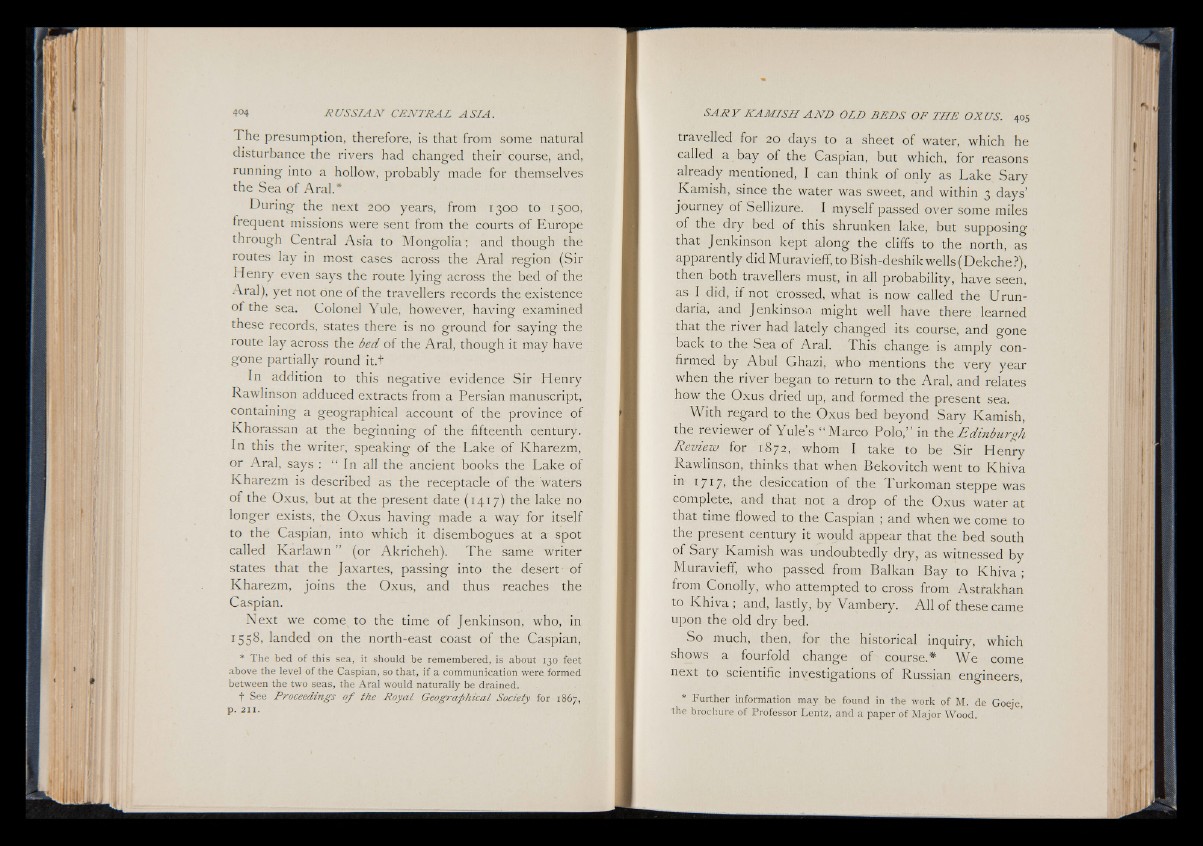
The presumption, therefore, is that from some natural
disturbance the rivers had changed their course, and,
running into a hollow, probably made for themselves
the Sea of Aral.*
During the next 200 years, from 1300 to 1500,
frequent missions were sent from the courts of Europe
through Central Asia to Mongolia-; and though the
routes lay in most cases across the Aral region (Sir
Henry even says the route lying across the bed of the
Aral), yet not one of the travellers records the existence
o f the sea. Colonel Yule, however, having examined
these records, states there is no ground for saying the
route lay across the bed of the Aral, though it may have
gone partially round it.I
In addition to this negative evidence Sir Henry
Rawlinson adduced extracts from a Persian manuscript,
containing a geographical account of the province of
Khorassan at the beginning of the fifteenth century.
In this the writer, speaking of the Lake of Kharezm,
or Aral, says I “ In all the ancient books the Lake of
Kharezm is described as the receptacle of the waters
of the Oxus, but at the present date (1417) the lake no
longer exists, the Oxus having made a way for itself
to the Caspian, into which it disembogues at a spot
called Karlawn ” (or Akricheh). The same writer
states that the Jaxartes, passing into the desert- of
Kharezm, joins the Oxus, and thus reaches the
Caspian.
Next we come, to the time of Jenkinson, who, in
1558, landed on the north-east coast of the Caspian,
* The bed of this sea, it should be remembered, is about 130 feet
above the level of the Caspian, so that, if a communication were formed
between the two seas, the Aral would naturally be drained.
f See Proceedings o f the Royal Geographical Society for 1867,
p. 211.
travelled for 20 days to a sheet of water, which he
called a bay of the Caspian, but which, for reasons
already mentioned, I can think of only as Lake Sary
Kamish, since the water was sweet, and within 3 days’
journey of Sellizure. I myself passed over some miles
of the dry bed of this shrunken lake, but supposing
that Jenkinson kept along the cliffs to the north, as
apparently did Muravieff, to Bish-deshikwells(DekcheP),
then both travellers must, in all probability, have seen,
as I did, if not crossed, what is now called the Urun-
daria, and Jenkinson might well have there learned
that the river had lately changed its course, and gone
back to the Sea of Aral. This change, is amply confirmed
by Abul Ghazi, who mentions the very year
when the river began to return to the Aral, and relates
how the Oxus dried up, and formed the present sea.
With regard to the Oxus bed beyond Sary Kamish,
the reviewer of Yule’s “ Marco Polo,” in thctEdinburgh
Review for 1872, whom I take to be Sir Henry
Rawlinson, thinks that when Bekovitch went to Khiva
in x 717, the desiccation of the Turkoman steppe was
complete, and that not a drop of the Oxus water at
that time flowed to the Caspian ; and when we come to
the present century it would appear that the bed south
of Sary Kamish was undoubtedly dry, as witnessed by
Muravieff, who passed from Balkan Bay to Khiva ;
from Conolly, who attempted to cross from Astrakhan
to Khiva; and, lastly, by Vambery. All of these came
upon the old dry bed.
So much, then, for the historical inquiry, which
shows a fourfold change of course.* We come
next to scientific investigations of Russian engineers,
* Further information may be found in the work of M. de Goeje,
the brochure of Professor Lentz, and a paper of Major Wood.